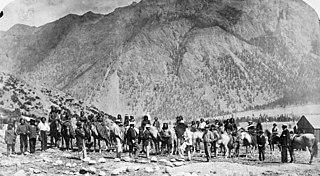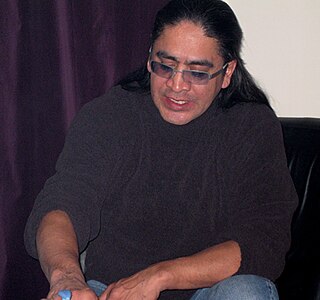
The Stʼatʼimc, also known as the Lillooet, St̓át̓imc, Stl'atl'imx, etc., are an Interior Salish people located in the southern Coast Mountains and Fraser Canyon region of the Interior of the Canadian province of British Columbia.

Sun Peaks Resort is an alpine ski resort located in Sun Peaks, British Columbia, Canada, 56 km (35 mi) northeast of Kamloops.
Tkʼemlúps te Secwépemc, abbreviated TteS and previously known as the Kamloops Indian Band, is a First Nations government within the Shuswap Nation Tribal Council, which represents ten of the seventeen Secwepemc band governments, all in the southern Central Interior region, spanning the Thompson and Shuswap districts. It is one of the largest of the 17 groups into which the Secwepemc (Shuswap) nation was divided when the Colony of British Columbia established an Indian reserve system in the 1860s.

Chase is a village located in the Interior of British Columbia, Canada. It has a population of 3,399, and its main industries are forestry and tourism. It is located at the outlet of Little Shuswap Lake, which is the source of the South Thompson River. Chase Creek, which drops over three small waterfalls before flowing through the town, enters the South Thompson just below the lake's outlet.

The Secwépemc, known in English as the Shuswap people, are a First Nations people residing in the interior of the Canadian province of British Columbia. They speak one of the Salishan languages, known as Secwepemc or Shuswap.
The Shuswap language is the traditional language of the Shuswap people of British Columbia. An endangered language, Shuswap is spoken mainly in the Central and Southern Interior of British Columbia between the Fraser River and the Rocky Mountains. According to the First Peoples' Cultural Council, 200 people speak Shuswap as a mother tongue, and there are 1,190 semi-speakers.
The Interior Salish languages are one of the two main branches of the Salishan language family, the other being Coast Salish. It can be further divided into Northern and Southern subbranches. The first Salishan people encountered by American explorers were the Flathead people, among the most easternly of the group.
The Neskonlith Indian Band is a First Nations government in the Canadian province of British Columbia located in the Shuswap district east of Kamloops. It is a member of the Shuswap Nation Tribal Council, one of two main governmental bodies of the Secwepemc (Shuswap) people. It was created when the government of the Colony of British Columbia established an Indian reserve system without the consent and without consultation with the indigenous population of the colony, in the 1860s. The Neskonlith Indian Band is named after Chief Neskonlith, and co-established by Chief Careguire, Chief Neskonlith's father. The original reserve created is what is known as the Neskonlith Douglas Reserve.
The Northern Shuswap Tribal Council is a First Nations government in the Canadian province of British Columbia. Based in the Cariboo District of the Central Interior, it is one of two tribal councils of the Secwepemc people, the other being the Shuswap Nation Tribal Council of the Thompson-Shuswap region farther south.
The Shuswap Nation Tribal Council is a First Nations Tribal Council in the Canadian province of British Columbia. Based in the Thompson and Shuswap Districts of the Central Interior, although including one band on the upper Columbia River in the East Kootenay region. It is one of two tribal councils of the Secwepemc people, the other being the Northern Shuswap Tribal Council of the Cariboo region farther to the north. The council is based in Kamloops, British Columbia.
The Adams Lake Indian Band is a member of the Secwepemc (Shuswap) Nation. It was created when the government of the Colony of British Columbia established an Indian reserve system in the 1860s. The Adams Lake Indian Band is a member band of the Shuswap Nation Tribal Council, which represents Secwepemc people in the Thompson and Shuswap districts of southern Central Interior region. Four Secwepemc governments farther north in the Cariboo belong to the Northern Shuswap Tribal Council. Chief Atahm School houses an immersion program important to keeping the Secwepemc language alive, and is located on an Adams Lake Indian Band Reserve.
The Shuswap Indian Band is a member government of the Shuswap Nation Tribal Council and also of the Ktunaxa Kinbasket Tribal Council, located in the East Kootenay region of the Canadian province of British Columbia. Its main reserve, the Shuswap Indian Reserve, is located one mile north of Invermere, British Columbia in the Columbia Valley region of the Rocky Mountain Trench on the upper Columbia River, on the other side of the Selkirk Mountains from other Secwepemc bands. It was created when the government of the then-Colony of British Columbia established an Indian reserve system in the 1860s. Though a member of the Ktunaxa Kinbasket Tribal Council and intermarried with the Ktunaxa bands in the same region, the members of the band are ethnically Secwepemc (Shuswap).

The Canim Lake Band is a First Nations government of the Secwepemc (Shuswap) Nation, located in the Central Interior region of the Canadian province of British Columbia. Its main Indian reserve is located at Canim Lake, British Columbia, near 100 Mile House. It was created when the government of the then-Colony of British Columbia established an Indian reserve system in the 1860s. It is a member government of the Northern Shuswap Tribal Council.
Xatśūll First Nation formerly known as Soda Creek Indian Band, is a First Nations government of the Secwepemc (Shuswap) Nation, located in the Cariboo region of the Central Interior region of the Canadian province of British Columbia. It was created when the government of the then-Colony of British Columbia established an Indian reserve system in the 1860s. It is a member government of the Northern Shuswap Tribal Council.
The Williams Lake First Nation is a First Nations government of the Secwepemc (Shuswap) Nation, located in the Cariboo region of the Central Interior region of the Canadian province of British Columbia, at the city of Williams Lake. It was created when the government of the then-Colony of British Columbia established an Indian reserve system in the 1860s. It is a member government of the Northern Shuswap Tribal Council. Its main Indian Reserve is Williams Lake Indian Reserve No. 1, a.k.a. "Sugarcane" or "The Cane" or "SCB".
The High Bar First Nation is a First Nations government of the Secwepemc (Shuswap) Nation, located in the Fraser Canyon-Cariboo region of the Central Interior of the Canadian province of British Columbia. It was created when the government of the then-Colony of British Columbia established an Indian reserve system in the 1860s. It is one of three Secwepemc bands that is not a member of either the Shuswap Nation Tribal Council or the Northern Shuswap Tribal Council. The High Bar people are also partly Tsilhqot'in and have links with some Chilcotin First Nations.
The Ktunaxa Nation or Ktunaxa Nation Council is a First Nations tribal council government comprising four Ktunaxa (Kutenai) bands in the south-east of the Canadian province of British Columbia. It is one of three Kutenai governments, the others being the Kootenai Tribe of Idaho and the Confederated Salish and Kootenai Tribes in the United States.

Little Shuswap Lake is a small lake in the Thompson River basin of the southern Interior of British Columbia, Canada, which sits at the transition between the Thompson Country to the west and the Shuswap Country to the east. It is fed by the Little River, which flows from Shuswap Lake, and is the main source of water for the South Thompson River, which begins at the lake's outlet at its southwestern end. The lake is approximately 7.8 kilometres (4.8 mi) in length, NE to SW, and averages 2.4 kilometres (1.5 mi) in width and is approximately 18 square kilometres (6.9 sq mi) in area. It has a mean depth of 14.3 metres (47 ft) to a maximum of 59.4 metres (195 ft).
The Simpcw First Nation, formerly known as the North Thompson Indian Band, is a First Nations band government based in the Thompson Country of British Columbia, Canada. It is a member of the Shuswap Nation Tribal Council. It is a First Nations government of the Secwepemc (Shuswap) Nation, located in the Central Interior region of the Canadian province of British Columbia. The band's main community is at Chu Chua, British Columbia. Four of the five First Nation Reserves in Simpcw territory were designated on July 5, 1877 and the fifth was designated on February 24, 1916. The Shuswap language name for North Thompson Band's community and reserve is 'Simpcw'.







